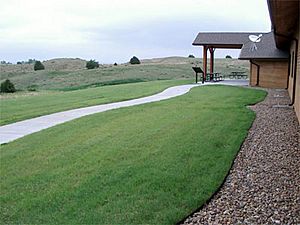Buffalograss facts for kids
Quick facts for kids Buffalograss |
|
|---|---|
 |
|
| Buffalograss used as a lawn | |
| Scientific classification | |
| Genus: |
Bouteloua
|
| Species: |
dactyloides
|
Bouteloua dactyloides, often called buffalograss or buffalo grass, is a type of grass found in North America. It grows naturally in Canada, Mexico, and the United States. This short grass is common on the High Plains. It often grows alongside another grass called blue grama (B. gracilis) across most of the shortgrass prairie regions.
It's important to know that the grass called "buffalo" in Australia is a different type of grass. It is not the same as Stenotaphrum secundatum, which has varieties like 'Sir Walter' or 'Palmetto'.
Contents
What Buffalograss Looks Like
Buffalograss is a type of short grass that lives for many years. It grows best in warm weather. This grass can handle dry weather, hot temperatures, and cold conditions very well.
Its leaves are usually about 5 to 13 centimeters (2 to 5 inches) tall. In the southern Great Plains, the leaves can grow up to 30 centimeters (12 inches) tall.
Most buffalograss plants have separate male and female flowers. This means some plants only have male flowers, and others only have female flowers. Sometimes, a single plant might have both male and female flowers, or even flowers that have both parts. The flower stalks can be 10 to 20 centimeters (4 to 8 inches) tall.
Male flowers grow in a loose cluster called a panicle. Female flowers grow in small, bur-like groups, usually with two to four tiny flower clusters in each bur.
Buffalograss sends out many spreading stems called stolons that grow along the ground. Sometimes, it also grows underground stems called rhizomes. It has many roots that spread out and fill the soil. These stolons and roots grow together to form a thick, dense layer of grass called a sod. Buffalograss roots are very thin, usually less than 1 millimeter (0.04 inches) wide.
Where Buffalograss Grows
Buffalograss is very common across most of the Great Plains. It can also be found in other nearby areas. These include the Prairie Provinces in Canada, down to central Mexico. It also grows in the Mississippi Valley and the Intermountain Region.
In Australia, B. dactyloides is not called buffalograss. Instead, people there call it 'prairie grass'.
How Buffalograss Got Its Name
The scientist Thomas Nuttall first put Bouteloua dactyloides into a group of plants called Sesleria. Later, it was moved to its own group called Buchloe. In 1999, a scientist named James Travis Columbus moved buffalograss again. He placed it in the group Bouteloua, which also includes other grasses like the grama grasses.
How People Use Buffalograss
For Lawns and Gardens
Buffalograss is a great choice for lawns in North America because it doesn't need much water. It is also grown as forage, which means it's used as food for animals.
Some types of buffalograss grown for lawns include '609', 'Prairie', 'Stampede', and 'Density'. Types grown for animal food include 'Comanche' and 'Texoka'.
Scientists at the University of California Riverside and University of California Davis have created a special type of buffalograss called 'UC Verde'. This type makes a thick, green lawn that can handle California's hot, dry summers.
Agricultural scientists at the University of Nebraska also developed a lawn variety called Legacy. You can start growing buffalograss from seeds, like the 'Cody', 'Bowie', and 'Sundancer' types. Or, you can plant it using parts of the plant, like the 'Legacy' and 'Prestige' types.
For Building Homes
Early settlers on the plains used the thick sod of buffalograss to build their homes. These homes were called sod houses.
Buffalograss Diseases
Buffalograss can get a plant disease called buffalograss false smut. This disease is caused by a tiny fungus named Porocercospora seminalis. When this fungus infects the grass, it stops the seeds from growing properly. This means the grass produces fewer seeds, and the seeds that are produced might not sprout well.

